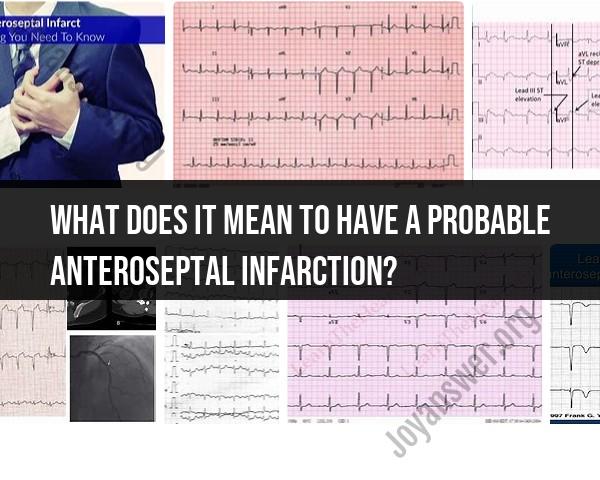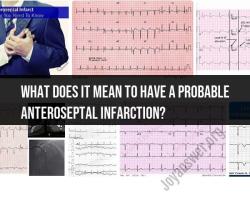What does it mean to have a probable anteroseptal infarction?
A "probable anteroseptal infarction" is a term used in medical diagnostics and cardiology to describe a potential heart condition, specifically a heart attack (myocardial infarction) that is suspected to have occurred in the anteroseptal region of the heart. Let's break down this terminology:
Anteroseptal: This term refers to a specific region of the heart, where the "antero" part signifies the front of the heart, and "septal" refers to the wall that divides the left and right ventricles of the heart. Therefore, the anteroseptal region is the front part of the heart's septum, which is the muscular wall that separates the left and right sides of the heart.
Infarction: An infarction is tissue damage or death due to a lack of blood supply, typically caused by a blockage in a coronary artery, leading to a heart attack. In the context of a "probable anteroseptal infarction," it suggests that there are signs on diagnostic tests, such as an electrocardiogram (ECG or EKG), that indicate possible damage or ischemia (lack of blood flow) in the anteroseptal region of the heart.
It's important to understand that the term "probable" in this context indicates uncertainty or a degree of likelihood. A "probable anteroseptal infarction" suggests that there are ECG findings or clinical indications that raise suspicion of a heart attack in the front part of the septum, but it may not be definitively confirmed. Additional testing and clinical evaluation, such as cardiac enzyme levels, echocardiography, or cardiac imaging, are often conducted to provide a more accurate diagnosis and determine the extent and severity of the heart condition.
Patients who receive this diagnosis will typically undergo further assessment and treatment by a healthcare professional, such as a cardiologist, to determine the appropriate care and management for their heart health. It's essential to consult with a healthcare provider to discuss the specific implications of a probable anteroseptal infarction and create a tailored treatment plan based on individual circumstances.
What does it signify to have a probable anteroseptal infarction in a medical context?
A probable anteroseptal infarction (ASI) in a medical context signifies that there is a high probability that the patient has suffered an AMI in the anteroseptal region of the heart. The anteroseptal region of the heart is located at the front of the heart and is responsible for pumping blood to the brain and other vital organs.
A probable ASI can be diagnosed based on a combination of clinical symptoms, ECG findings, and blood tests. Clinical symptoms of a probable ASI may include chest pain, shortness of breath, nausea, and diaphoresis. ECG findings of a probable ASI may include ST-segment elevation in the anterior leads (V1-V6) and Q waves in the anterior leads. Blood tests may show elevated levels of cardiac biomarkers, such as troponin and CK-MB.
The implications of a probable ASI are significant. AMI is a serious medical condition that can lead to heart failure, arrhythmias, and death. Patients with a probable ASI need to be hospitalized and treated with medications to reduce the risk of these complications.
How is a probable anteroseptal infarction diagnosed, and what are the implications?
A probable anteroseptal infarction (ASI) is diagnosed based on a combination of clinical symptoms, ECG findings, and blood tests.
Clinical symptoms:
- Chest pain
- Shortness of breath
- Nausea
- Diaphoresis
ECG findings:
- ST-segment elevation in the anterior leads (V1-V6)
- Q waves in the anterior leads
Blood tests:
- Elevated levels of cardiac biomarkers, such as troponin and CK-MB
The implications of a probable ASI are significant. AMI is a serious medical condition that can lead to heart failure, arrhythmias, and death. Patients with a probable ASI need to be hospitalized and treated with medications to reduce the risk of these complications.
What medical assessments and follow-up may be required in cases of probable anteroseptal infarction?
Patients with a probable ASI will need to be hospitalized and monitored closely for signs of heart failure, arrhythmias, and other complications. Medications such as aspirin, clopidogrel, heparin, and beta-blockers may be used to reduce the risk of complications.
Once the patient is stabilized, they may need to undergo further medical assessments, such as an echocardiogram or cardiac catheterization, to determine the extent of the damage to the heart and to assess the risk of future cardiovascular events.
Follow-up care for patients with a probable ASI will vary depending on the individual patient's needs. However, most patients will need to be seen by a cardiologist on a regular basis for follow-up care.
Here are some of the medical assessments and follow-up that may be required in cases of probable anteroseptal infarction:
- Echocardiogram to assess the structure and function of the heart
- Cardiac catheterization to assess the coronary arteries for blockages
- Stress test to assess the heart's ability to pump blood during exercise
- Holter monitor to monitor the heart rhythm for 24 hours
- Medications to reduce the risk of blood clots, such as aspirin and clopidogrel
- Medications to reduce the risk of heart failure, such as ACE inhibitors and beta-blockers
- Cardiac rehabilitation program to help the patient recover from the ASI and to reduce the risk of future cardiovascular events
The specific medical assessments and follow-up that are required will be determined by the patient's cardiologist based on the individual patient's needs.



